Off-grid cabins have gained plenty of attention in recent years, so it stands to reason why you’re itching to learn more about them.
In fact, chances are you’re probably here after reading our Beginner’s Guide to Owning A Solar-Powered Cabin.
Whether you build one to establish a self-sufficient lifestyle or simply for recreational purposes, the idea of sustainable but contemporary living has a lot of attractive perks. The most common reason being utility savings.
Today we’ll share all we know to get you started with planning your tailor-made off-grid cabin.
Table of Contents
What Is An Off-Grid Cabin?
It’s common knowledge that off-grid cabins, in principle, are self-sufficient shelters that are partially or wholly independent of public utilities.
However, there is no strict definition of what is an off-grid cabin is.
Many of you will prefer having various degrees of autonomy when it comes to your utilities (telecom, electricity, heating, food, and water). This mostly depends on where you put yourself in the off-grid cabin spectrum.
Some of you prefer the most straightforward setup, removing yourself from the system entirely.
Alternatively, you may want to have your off-grid cabin in an area with access to some utilities, services, and technologies as a backup if something goes wrong.
In summary, off-grid cabins are homes that run themselves either partially or fully. It all depends on preference and access to necessities such as food, electricity, water, and technology.
What Does It Cost To Build An Off-Grid Cabin?
Broadly speaking, a 5kW solar panel system without energy storage in the USA will cost you $14,000-$19,000.
On the other hand, a 5kW wind turbine alone costs $28,375.
For those of you looking to store energy, a typical 5kW / 7.5 kWh energy storage system will cost you $14,281.
Before we show you how we arrived at these figures, let’s set some expectations:
While we did mention that off-grid cabins are intended to be independent of ALL utilities, for now, we’ll limit the scope of this article to the electrical element.
Now, let’s proceed with the cost analysis.
First: Estimate the Power And Energy Needs in Your Off-Grid Cabin
We understand that you’re wanting to meet your own electrical demands. Therefore, we’re going to provide you with the basics so that you can do your own calculations.
We guarantee that this approach will leave you feeling confident once you get the hang of it.
In a nutshell, you want to figure out how much power and energy you need to run your entire off-grid cabin throughout the year.
The main keywords here are power and energy. There is a difference between the two (kW vs. kWh), and you must know the basics fully appreciate the wisdom bombs we are about to drop.
Now, let’s share with you an overview of our step-by-step methodology:
- Write down all the appliances you want to operate
- Look at each appliance’s “nameplate rating,” then add all the watt ratings.
- Estimate how many hours you want to operate each appliance
- Use the energy formula to get your total daily energy needs
- Multiply your daily energy needs by 365 to get your yearly energy requirements.
As you can see, most of the step descriptions are pretty self-explanatory. But, to maximize retention, we’ll go through each step using a sample off-grid cabin.
Step 1: Write Down Your Appliances
| Typical Appliances |
| Coffee Maker |
| Microwave |
| Regular Refrigerator / Freezer |
| Toaster |
| Laptop and Cellphone |
| Lightbulbs |
| Airconditioner |
Step 2: Add Your Appliances Power Ratings
Look at the nameplate of each appliance and search for their watt ratings. We have included a sample fridge nameplate in the image below for your convenience.
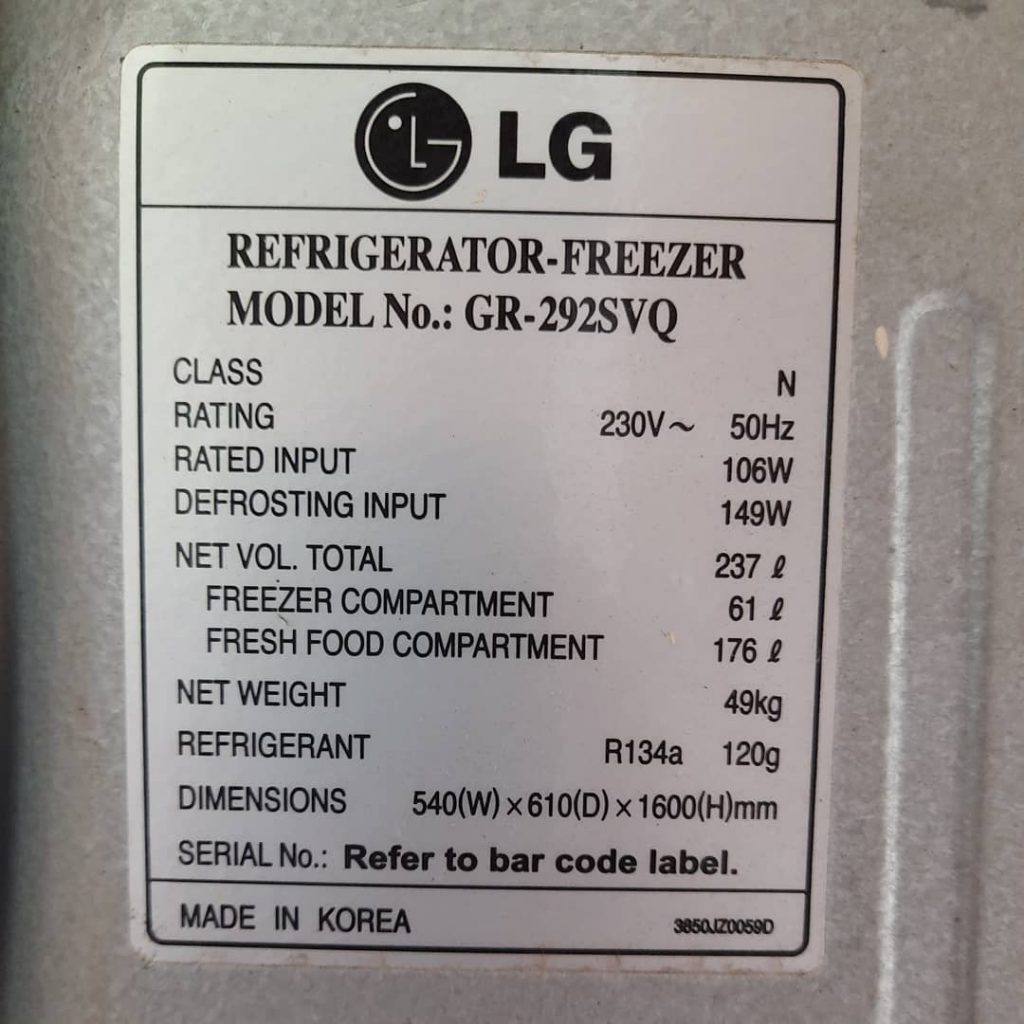
Source: W.A Maintenance Electricals
| Typical Appliances | Rated (Running) Watts |
| Coffee Maker | 1100 W |
| Microwave | 800 W |
| Regular Refrigerator / Freezer | 700 W |
| Toaster | 800 W |
| Laptop and Cellphone | 100 W |
| Lightbulbs | 150 W |
| Airconditioner | 1200 W |
| Total Solar Panel Size | 4,850 W |
You’ll need about 5kW (based on the 4.85kW) worth of power to run everything simultaneously.
Now, depending on which natural resource is abundant and economical in your location, you can begin planning how many units of renewable energy (RE) generators (wind, solar, or even hydro and biomass) you need.
Step 3: Estimate How Many Hours You Want to Operate Each Appliance
So, you need 5kW worth of power to run our off-grid cabin. This is where steps three to five come in.
First, let’s start small — figure out how many hours you are planning to run each device.
| Typical Appliances | Rated Power | Running Hours |
| Coffee Maker | 1100 W | 0.1 |
| Microwave | 800 W | 0.15 |
| Regular Refrigerator / Freezer | 700 W | 24 |
| Toaster | 800 W | 0.1 |
| Laptop and Cellphone | 100 W | 5 |
| Lightbulbs | 150 W | 5 |
| Airconditioner | 1200 W | 8 |
| Total Solar Panel Size | 4,850 W |
Step 4: Use the Energy Formula to Get Your Total Daily Energy Needs
Use this simple energy formula to get your total energy consumption, expressed in kWh.
The formula for kWh energy is power (kW) multiplied by the number of hours (h).
Energy = Power * Time
| Typical Appliances | Rated Power | Running Hours | Energy Consumption |
| Coffee Maker | 1100 W | 0.1 | 110 |
| Microwave | 800 W | 0.15 | 120 |
| Regular Refrigerator / Freezer | 700 W | 24 | 16,800 |
| Toaster | 800 W | 0.1 | 80 |
| Laptop and Cellphone | 100 W | 5 | 500 |
| Lightbulbs | 150 W | 5 | 750 |
| Airconditioner | 1200 W | 8 | 9,600 |
| Total Solar Panel Size | 4,850 W | 27,960 Wh |
And there you have it. 27,960 watt-hours to run your devices daily as needed.
We do however have some good news — heat-regulating equipment such as refrigerators and air-conditioners actually consumes less than the numbers show us.
Refrigerators and ACs have a significantly lower running wattage than what you see on their nameplate. They cycle on and off throughout the day when they sense that the ambient temperature is already achieved. God bless innovation and higher efficiency.
Therefore, we can assume a third of your fridge and AC’s rated power as an acceptable running wattage, leaving you with about 5.6kWh and 3.2kWh, respectively.
Consequently, here is our updated table
| Typical Appliances | Rated Power | Running Hours | Energy Consumption |
| Coffee Maker | 1100 W | 0.1 | 110 |
| Microwave | 800 W | 0.15 | 120 |
| Regular Refrigerator / Freezer | 700 W | 24 | 5,600 |
| Toaster | 800 W | 0.1 | 80 |
| Laptop and Cellphone | 100 W | 5 | 500 |
| Lightbulbs | 150 W | 5 | 750 |
| Airconditioner | 1200 W | 8 | 3,200 |
| Total Solar Panel Size | 4,850 W | 10,360 Wh |
Admit it, you feel a lot better now!
Step 5: Multiply Your Daily Energy Needs By 365
Finally, you’re at the home stretch! This one is straightforward — take your daily energy needs, then multiply them by 365.
10.36 kWh per day x 365 days = 3,781.4 kWh
Is Your RE System Enough?
So is a 5kW RE system enough to generate 3,781.4 kWh of energy each year? Well, it depends. Like we said, each location will have a varying abundance of peak sun hours and wind power.
But based on our experience, a 5kW system, be it wind or solar, is enough to generate about twice your energy needs.
For those looking for empirical proof, here is a sample computation from the National Renewable Energy Laboratory (NREL) ‘s PV Watts for a 5kW system in California USA.
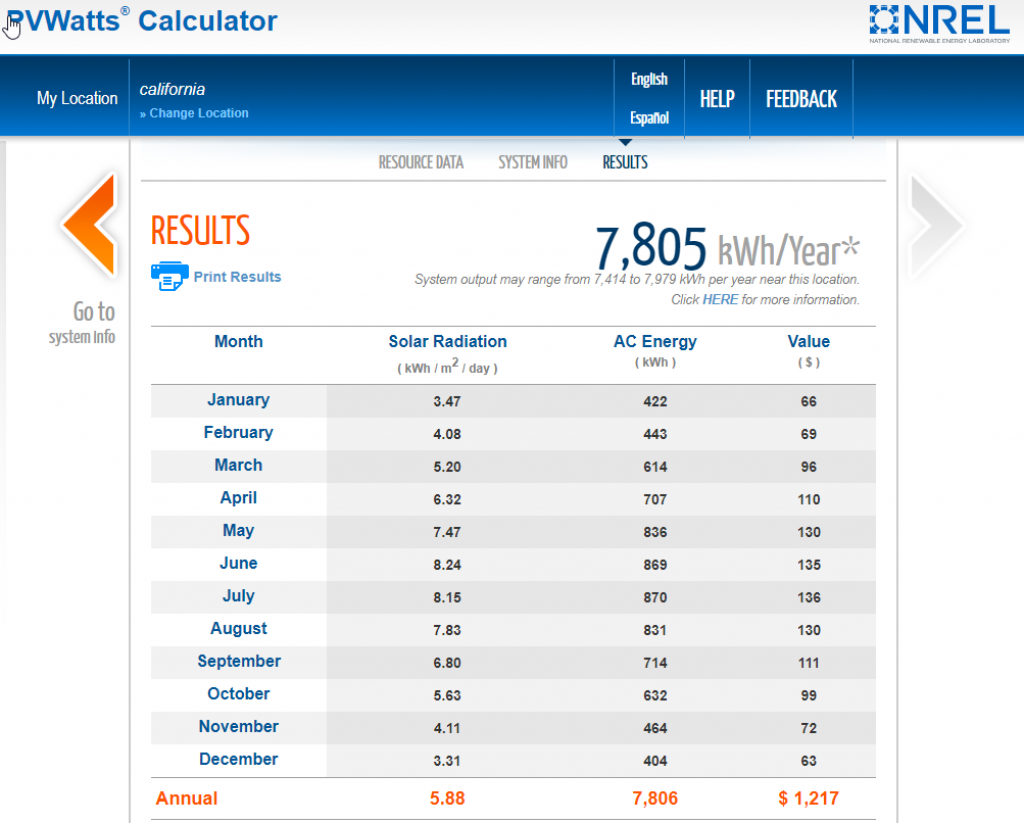
Cost
Quick Recap: Our sample off-grid cabin needs 5kW worth of peak power to provide at least 3,781.4 kWh annually.
Arguably, you can go with either wind or solar generators, depending on where you are. Both are viable. But in terms of ease of installation and maintenance, solar wins, in our opinion.
Cost Of Solar Panel System
According to NREL, the national average benchmark price for residential solar systems (3-10kW) in the United States is about $2.7/Watt DC or $3.1/Watt AC compared to $12/Watt back in 2000.
Using this as a reference, a 5kW solar system will cost you between $14,000 – $19,000, depending on which state you are in.
Of course, not all of our readers are from America. Therefore, we also analyzed the solar panel costs for other countries such as the United Kingdom, Australia, Canada, and South Africa.
Cost Of Wind Turbine System
Wind turbines are considerably more expensive than solar — according to another NREL white paper report, residential wind turbines are priced at $5.675/Watt.
Therefore, a 5kW wind turbine system will cost you $28,375. That’s a fair bit more expensive. Despite this fact, wind turbines convert more natural resources to energy (30-50%) than solar (15-20%). Remember, the wind is there 24/7 while the sun is not.
However, solar in a residential setting is definitely more convenient than wind turbines. It’s also worth pointing out that residential wind turbine systems are typically 20kW. For these reasons, we encourage you to pick the latter unless you have a good chunk of land in Texas, Iowa, Oklahoma, Kansas, and Illinois.
Cost Of Energy Storage
Whether you picked wind or solar, long-duration energy storage is essential for off-grid cabins. Having energy storage around allows you to mimic the load profile of a typical household without relying on any local utilities.
For example, the average residential load profile in the UK looks like this.
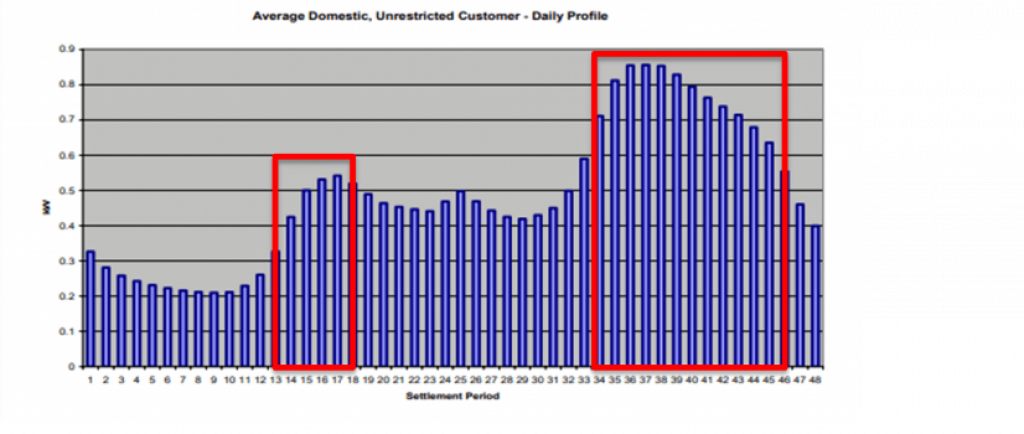
If you want to follow this behavior, you need energy storage to ensure adequate electricity is available from 7 to 8 am (small red box) and 5 pm onwards (big red box).
So let’s talk cost. In general, you are looking at an additional $14,281 for a 5kW / 7.5 kWh energy storage system. This should definitely cover your needs.
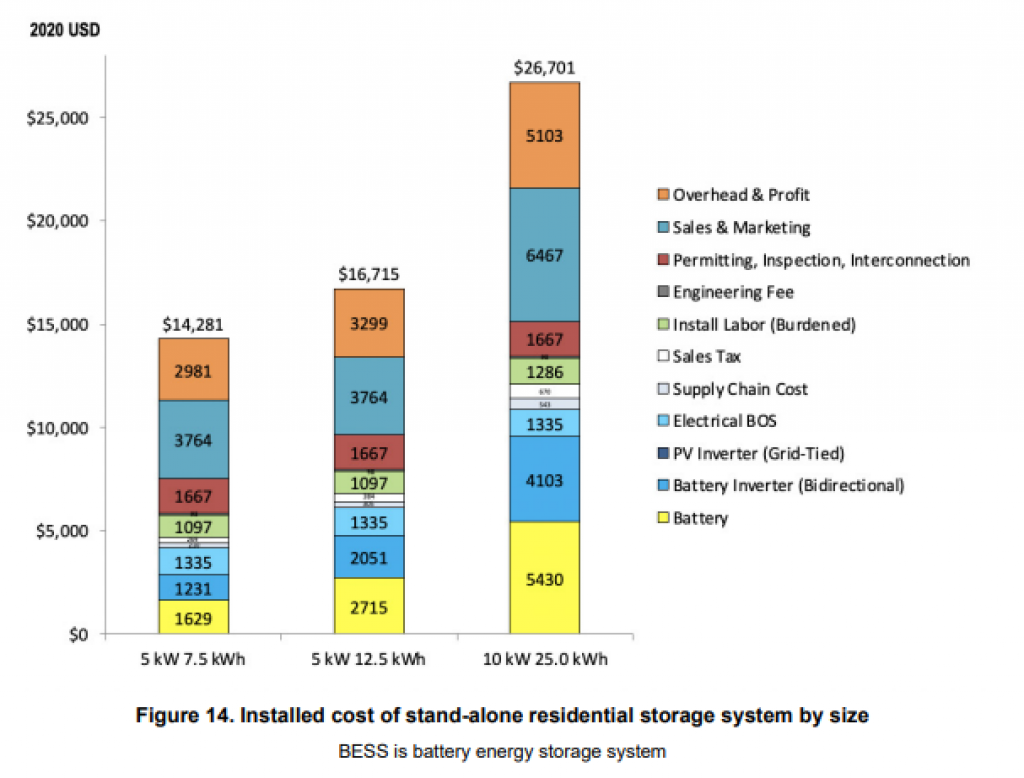
Source: NREL
Which Form Of Energy Production Is Best For An Off-Grid Cabin?
So which RE technology should you gun for? Well, it depends, but for us, the more convenient choice here is solar for the following reasons:
- While there are existing resources to determine abundance of wind energy, solar tools are relatively more accessible for small-scale;
- Even after consulting a reliable wind data toolkit, more detailed local measurements should be taken before developing a wind project;
- Solar developers are more prevalent than wind turbine counterparts;
- Wind turbines require more real estate to build compared to solar
What Solar Kit Is Best For An Off-Grid Cabin?
If we managed to convince you that solar is the more suitable choice for your case, you’re probably thinking about what solar kit is best for an off-grid cabin.
The best way to do this is to look for a local installer in your area to do the work for you. However, if you are looking to DIY, here are our top picks:
Long-Duration Energy Storage
For energy storage, here are your options.
Option 1: Buy a Tesla PowerWall
Option 2: Look for Tesla PowerWall Alternatives
Option 3: Build a DIY PowerWall using long-duration lithium-ion energy storage.
| Brand | Voltage | Energy Capacity | Description |
| Ampere Time LiFePO4 Deep Cycle Battery | 12V | 300Ah | with Built-in BMS |
| Ampere Time LiFePO4 Deep Cycle Battery | 12V | 200Ah | with Built-in BMS |
| Renogy Smart LiFePO4 w/ Self-Heating | 12V | 170Ah | Self-heating function Auto-Balancing |
| Renogy 12V 200AH Rechargeable Deep Cycle | 12V | 200Ah | Hybrid GEL Battery |
Charge Controller
In a nutshell, charge controllers exist to protect your batteries from over-charging and discharging by controlling voltage and current. Usually, we’d let you decide how to select your own charge controller, but we recommend MPPT types for off-grid cabins.
Sure, you’ll be spending more, but trust us, it’ll save you a lot of headaches in the future.
Our top pick for this category is the Victron Energy MPPT Charge Controller. However, the Renogy Rover MPPT Solar Charge Controller is also good — purchase Renogy batteries with the latter for better compatibility.
Inverters
Lastly, a couple of 3 kW pure sine wave solar inverters — this is the last piece you’ll need to complete your solar kit.
By the end, you should end up with something like this
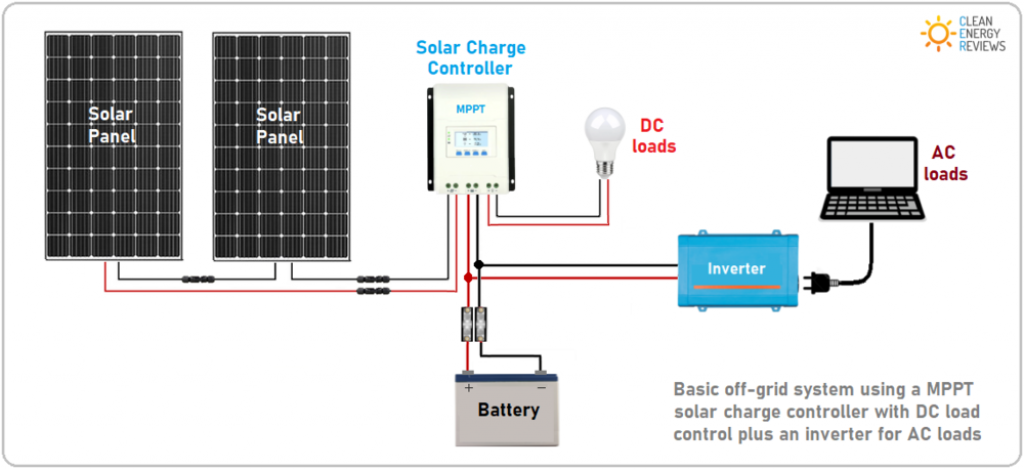
Source: cleanenergyreviews
How To Keep Warm In An Off-Grid Cabin?
This might sound shocking to some, but you don’t necessarily need electricity to keep warm in an off-grid cabin. Instead, you can build a fireplace or a furnace, then use common wood as a natural combustible in your area.
And yes, you can buy electric furnaces, but that is a costly add-on.
Where Are The Best Locations To Build An Off-Grid Cabin?
So, where are the best places to build your off-grid cabin? Well, it should be a place where you have access to water and food. Secondary considerations are:
- Affordability
- Climate
- Crime rate
- Proximity to backup utilities
- Real estate space
United States
Living off-grid in the U.S. is really a personal preference. But we managed to get some valuable insight from offgridworld.com and liked their recommendations, particularly Florida, Colorado, and Northern California.
Though it must be noted that building off-grid cabins with solar panels in southwestern states will definitely help your ROI.
United Kingdom
Living off-grid in the U.K. can be tricky since laws require you to get planning permission to build something new. Not to mention, real estate is expensive there. However, we did find out that it’s more feasible to build an off-grid cabin somewhere remote from a city, like West Wales.
Canada
Well, the good news is that almost all of Canada is an excellent place to go off-grid. However, be warned that the climate there isn’t ideal for solar. You’d probably get your money back in 12 to 16 years, like the United Kingdom.
Australia
Living off-grid in Australia isn’t as rare as you may think. There are already existing communities that can help you get started. The ones we found are Chewton Bushlands, Cohousing Australia Initiative, and Tiny Homes Australia which offer comprehensive guides on how to go off the grid.
Location-wise, we found that Queensland, Victoria, and South Australia are good places to consider.
Not to mention, Australia is the best place to earn back your solar investment among all the countries we’ve mentioned.
Examples Of Off-Grid Cabins
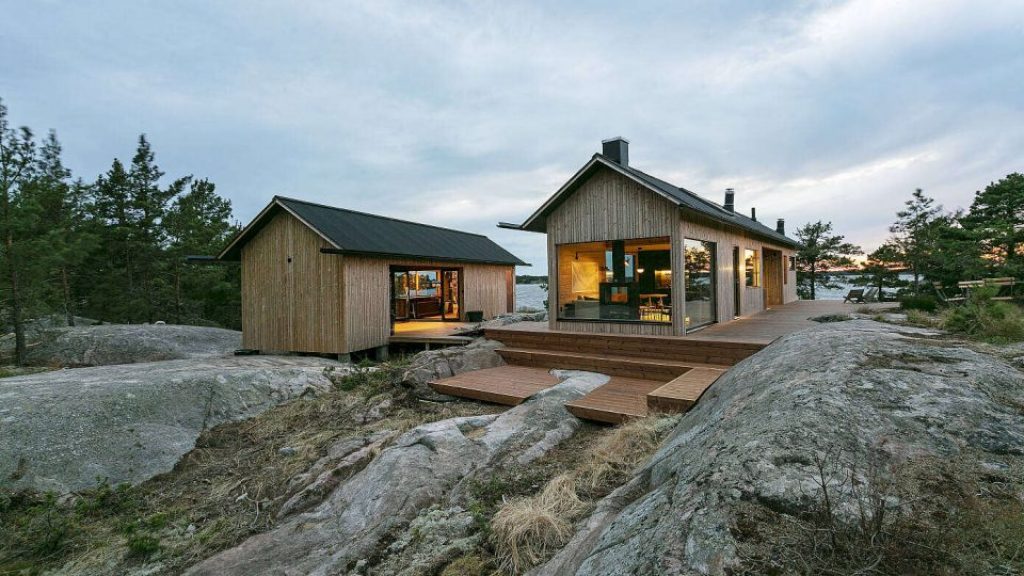
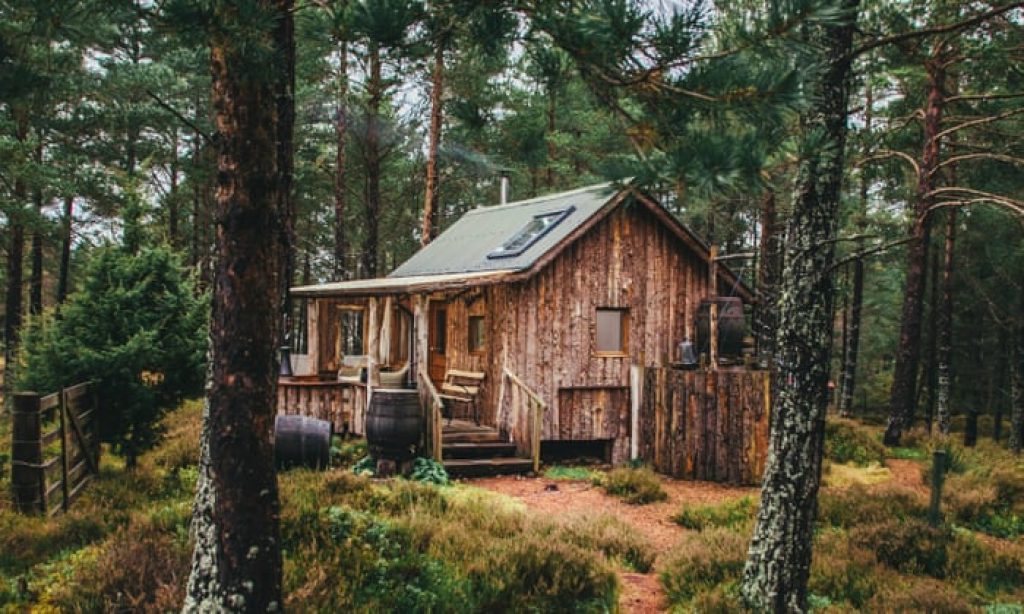
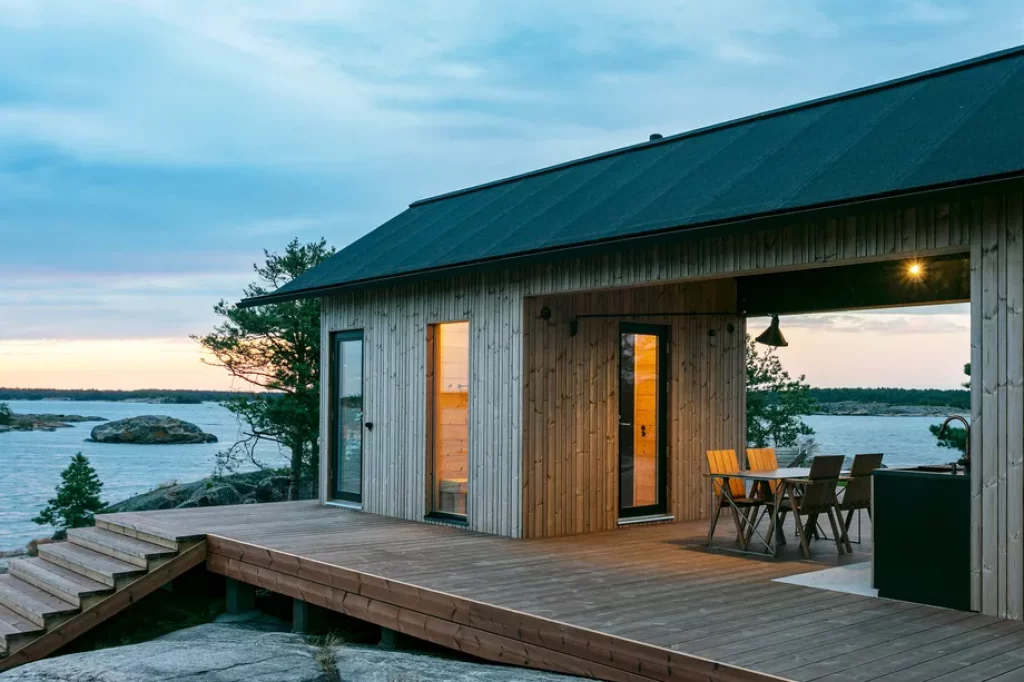
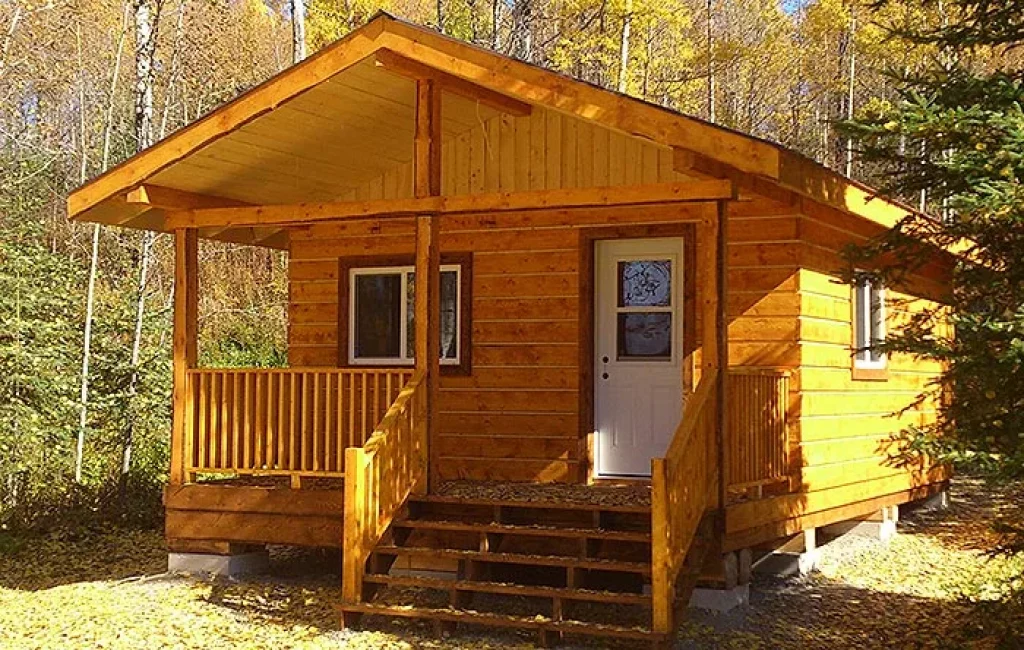
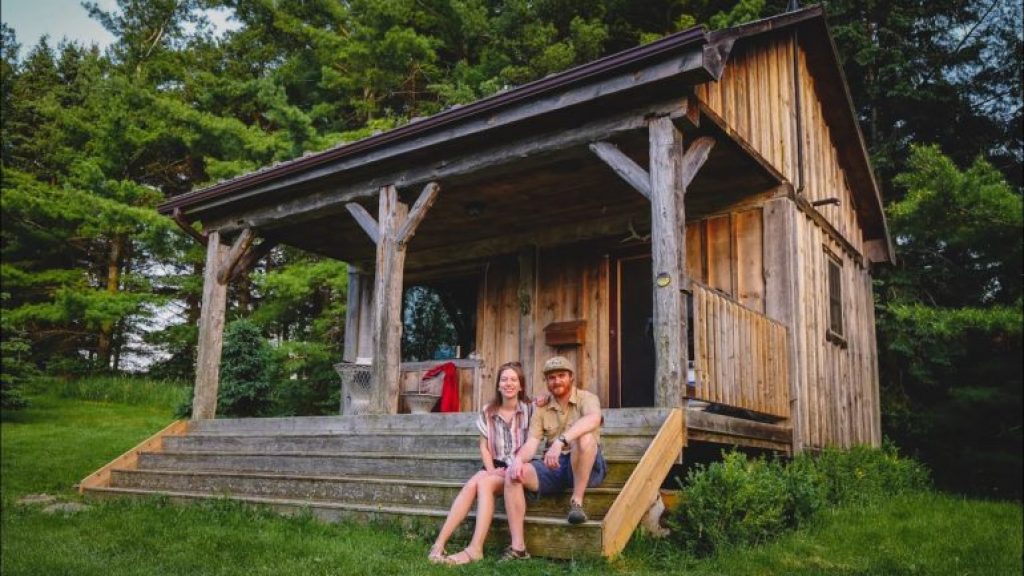
Final Thoughts
As mentioned at the beginning of this article, the off-grid cabin topic is a vast ocean. But, getting the electricity up and running is a start.
Let us know in the comments section what subtopics you need help with in the future. We’d be happy to create spin-off articles from this one.

